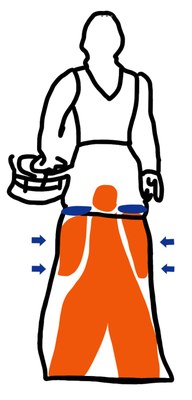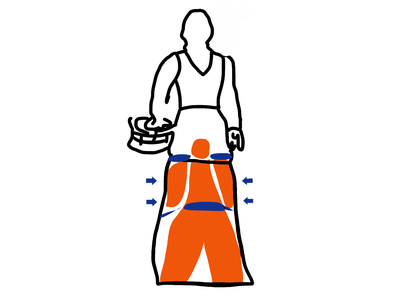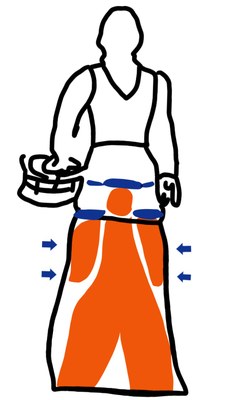
- The fact that giants dance makes them dance leads us to explain how the giants of the Basque Country are inside, how the system allows us to interact with the figure of more than three meters above us.

The challenges posed by a figure over three meters above our shoulders are summarized in weight and balance point. The result of the two combined elements is a giant inertia that must be taken into account when dancing. In order to play with these three elements, we need good restraint. Currently, there are three models of giants in Euskal Herria regarding the elements of support:
The system of cinemas and hands is the one used most in the past in many comparisons: it simply allows the giant to be held, but it makes it difficult to move any kind of direction or dance. When the giants marched without dancing, the system was enough, as the balance point barely moved.The system of fibers, hands and waist gives greater stability to the image, but prevents the work of the hip by transmitting the movement to the giant, which makes the movement more vertical than the horizontal. Highly recommended when using a short step for dance.
The system of cinemas, hands and heads doesn't seem so stable, but on the other hand, once the balance is controlled, it turns out what I call the theory of the triangle.
- We get the required balance point with your head
- We make strength with the righteous with our shoulders
- We turn with our hand on the donkey and support the elbows at the side crossings, we join the giant, endowed with stability.
Elbows and hips serve to give the giant's natural swing, as a person dancing, and to control and naturalize its movement. On the side crossings, elbows pressure transmits our body movement to the giant's hip, and at the same time, the movement of the shoulders reaches the giant's shoulders.
This system allows us to extend the displacement and the swing, so that the movement of the giant is coordinated among its internal elements, such as the movement of human beings. In my view, it is appropriate that the movement should be adjusted as far as possible to the size of the giant. If the displacement is short and not prolonged, the giant moves, but the movement is artificial, the role that the dancer's shoulders and hips can play is destroyed.
On the other hand, it should be noted that nowadays each comparison seeks his style, his signs of identity, as it happens in the traditional dance that takes place in different peoples, with many nuances that give him life and wealth.



Image: Patxi Laborda
Patxi Laborda Dantza.eus has also published six other chapters:
- About the Giant Tradition 1
- Around the giant tradition 2: Past accounts
- Around the Giant Tradition 3: Why choreographies?
- About the Giant Tradition 4:Model of the Comparison of Giants of Pamplona
- Around the giant tradition 5: Gaitas and Gaiteros